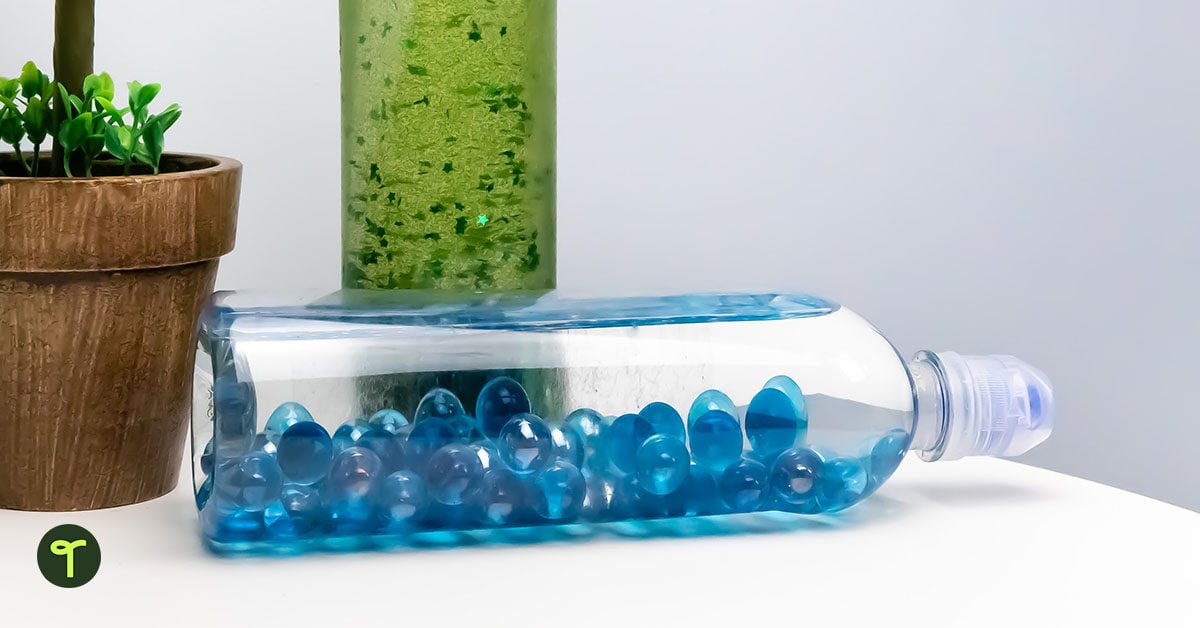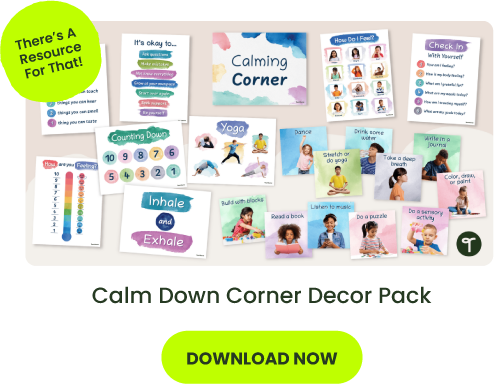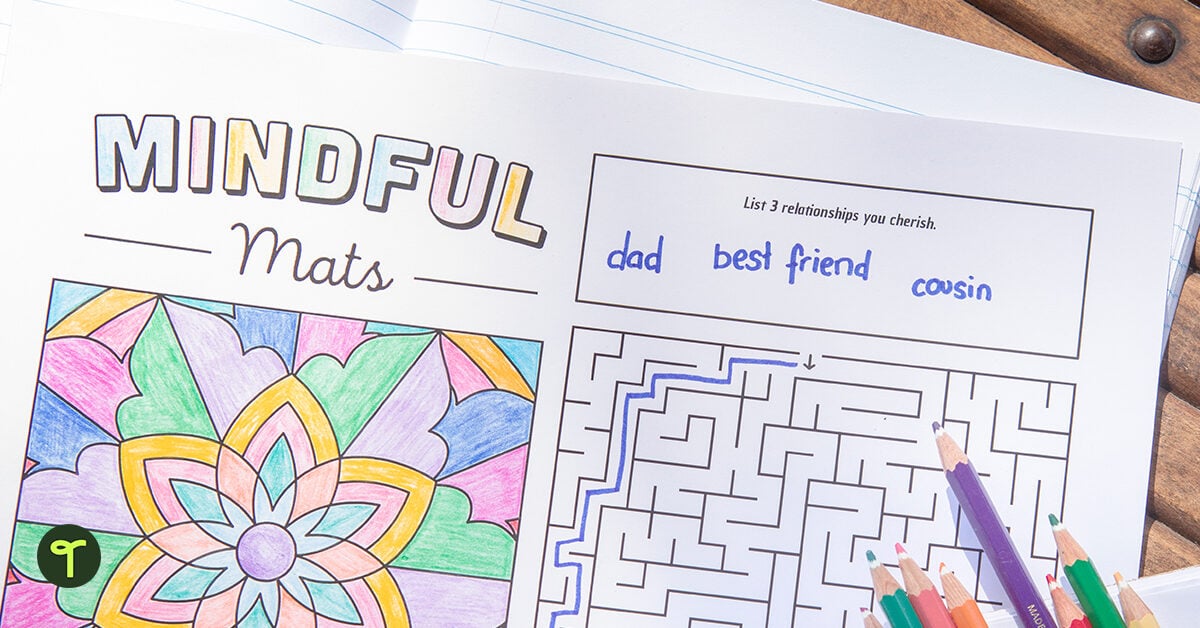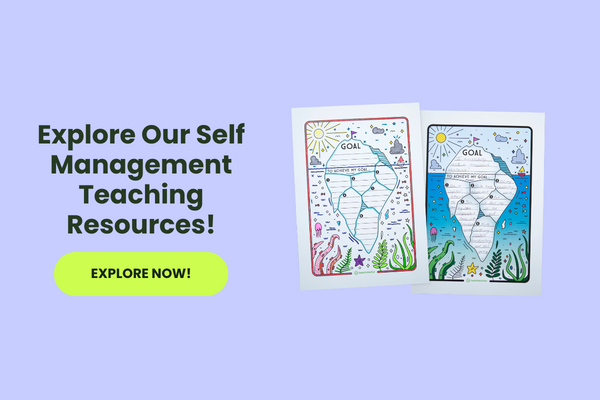Do you need fresh ideas for your classroom calm down corner this school year?
With a whopping 87 percent of American schools reporting their students are struggling with social and emotional development in the wake of the pandemic, providing safe spaces for our students to cool down and chill out when they’re struggling with complicated emotions is more vital than ever.
So how do you create a calm down corner in the classroom? What do you put in this chill out zone? And what, exactly, is a calm down corner, anyway?
The teachers on the Teach Starter team sat down to compile a list of their best calm down corner ideas to help make this space easier to create in your classroom and truly helpful for your students! Read on for their tips!
What Is a Calm Down Corner?
Before we share our best ideas, we need to define what it is we are talking about here. A calm down corner in a classroom is a designated space where students can go to manage their emotions, practice self-regulation and find a sense of calm when they are feeling overwhelmed or upset.
The goal of these spaces is to give students a space where they can remove themselves from the situation and recollect themselves. It also provides opportunities for diffusing a negative emotion or situation before it escalates. Providing this space to your students is a great way to help them develop their coping skills!
If this sounds familiar, but you haven’t heard the name, it may be because calm down corners are called something different in your school district. Calm down corners go by many names, including:
- Regulation zones
- Chill out zones or corners
- Peace corners
- Quiet corners
- Regulation stations
- Vacation stations
How to Create a Calm Down Corner in the Classroom
Now that we’ve defined the concept, let’s go straight to what you’ve been waiting for — calm down corner ideas to create your own in your classroom! Keep in mind that whatever you include (and whatever you call it), this quiet place should be set up away from student desks and whole-class meeting areas. This can be difficult in a small classroom, but to be effective, students need to be able to achieve some separation from their classmates.
Use Calming Colors
Did you know some colors are better than others for mental health? The experts say colors from nature, such as blues and greens, tend to be more calming, and these would be perfect in a regulation station in the classroom, complemented by whites, grays and other neutral tones.
If possible, avoid bright red and orange, as these colors can increase negative emotions.
The other advantage of using specific calming colors in this section of the classroom? It’s a visible reminder to all children that it is a safe and peaceful place in their classroom for calming down, separate from the rest of the space.
Incorporate Emotional Awareness
Supply your students with visual aids like emotion charts or feeling cards to help them identify and label their emotions, fostering emotional literacy.
You can encourage students to reflect on their feelings and choose the emotions they are experiencing on the charts or cards. This not only promotes emotional self-awareness, but it also empowers your students to take steps toward emotional regulation and well-being.
Understanding their emotions can ease students’ anxiety as it allows them to make sense of their feelings and put them into perspective.
Provide Headphones
The small space of a classroom may make it hard for students to truly “escape” to your classroom’s quiet corner, but a pair of good headphones can help students drown out the noise so they can refocus.
If you have an extra iPad or laptop available, consider queuing up one of our mindful breathing videos for students to watch or listen to through the headphones. These short, guided sessions can help regulate emotions, reduce stress, and support smoother transitions back to learning.
[resource:4492707]. [resource:5074724]. [resource:5003241]
Set Rules and Expectations
Just as you would set rules for using your classroom library or lining up for lunch, it’s important to set rules and expectations for using your chill-out corner that students will need to respect and follow.
Some sample calm-down corner rules you might use include:
- Don’t use the calm-down corner as a replacement for asking for help when needed.
- Students should not disturb classmates who are using the calm-down corner.
- Students should respect the privacy of those who use the calm-down corner. That means not asking the students why they are in the corner and not discussing the students’ emotional experiences with others without their permission.
- If there are any tools (such as books or stress balls) available in the calm-down corner, students should use them appropriately and put them back where they were found.
- A time limit may be enforced. Remind students that the calm-down corner is meant for short breaks to regain composure and emotional control. It’s not a space where they can go simply to avoid a lesson.
- Students are required to present a “chill out pass” before they go to the corner.
 Include Seating
Include Seating
The average tile floor in the classroom isn’t exactly conducive to sitting down and chilling out. Provide students with a space to sit, even if it’s just for 5 or 10 minutes, so they can collect themselves.
You don’t have to spend a ton of money on seating! Here are some ideas from our teacher team that make great classroom seating for a calm down corner (or your classroom library):
- Fluffy bath mats
- Blown-up inner tubes
- Balance cushions
- Bean bags
Provide Fidgets and Other Sensory Items
For students to get the most out of the time they spend calming down in your quiet corner, provide a few tangible tools that help students regulate their emotions. This can include stress balls, fidget toys (like the Pop It being used by a student above), sensory bottles or breathing exercises.
One teacher on the Teach Starter team made this simple sensory bottle (see below) with a water bottle, baby oil and blue beads.

Some kids may need an outlet to get rid of angry emotions. Keep a supply of scrap paper for them to scrunch or rip up and a small tub of play-dough for them to squeeze and roll out.
Your rules and expectations should spell out what students should do with these materials after they’re done, including clean-up of all that paper!
Include Books to Help Kids Navigate Emotions
Depending on how much space you have in your classroom, you might want to combine your classroom library with your quiet corner.
Even if these are two separate areas, including a few books in the quiet corner distracts kids from their emotional state. You can also choose books to help your students identify and express an emotion they are feeling to others.
Here are just a few you might want to add:
- Visiting Feelings by Lauren Rubenstein — This book for kids 4 to 8 was written by a licensed psychologist and encourages kids to sit with their emotions and understand them in a non-judgmental way.
- Listening to My Body by Gabi Garcia — Also available in Spanish, this book from a licensed professional counselor helps kids recognize physical sensations and emotions in their bodies, promoting self-awareness and emotional intelligence.
- When Sophie Gets Angry – Really, Really Angry… by Molly Bang — One book in a series of three, Bang’s book for younger kids explores the emotion of anger and shows how the character Sophie learns to cope with it in a positive way.
Add Art Materials
Drawing and coloring are a form of art therapy and help kids to calm down and express emotions. In your calming corner, keep a supply of coloring sheets or mindful activities like the one below, plain paper, crayons or markers and sharpened pencils for students to use.
Provide Materials for Deep Breathing
Deep breathing exercises are a simple but effective way to calm children down. Provide kids with materials that lead them through step-by-step breathing activities —like these mindful breathing task cards — so they can employ this tool on their own!












Comments